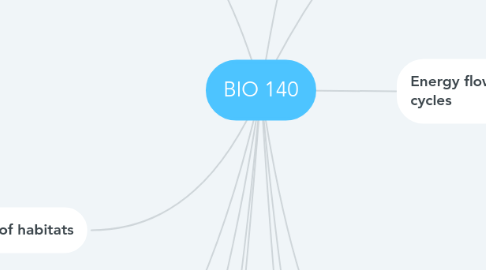
1. Ecology
1.1. Is the study of relationships between organism and their environment
1.2. Biotic- living
1.2.1. animals
1.2.2. bacteria
1.2.3. plants
1.2.4. viruses
1.3. Abiotic- nonliving
1.3.1. soil
1.3.2. water
1.3.3. atmosphere
1.4. Ecosystem- a collection of related parts functioning as a whole unit
1.4.1. population- a group of interacting organism o the same species
1.4.2. community- all interacting populations of an ecosystem
1.5. Natural selection- survival of the fittest
1.6. niche- it like the organism job
2. Biodiversity of habitats
2.1. it's the variety of ways that species interact with one another
3. Evolution/Natural selection/adaptation
3.1. Evolution- change in population over time
3.2. NS- survival of the fittest
3.3. Adaptation- a change an organism makes to be better suited for it's environment
4. Microclimate and plant communities
4.1. Microclimate- an area where that is totally different from the areas surrounding it
4.2. Plant communities- is a group of plants (sharing the same environment) that interact with each other, the animals, and the physically environment
5. Science literacy
5.1. Bias- when someone puts their own opinions and feelings into data causing it to be incorrect
5.1.1. Therefore bias is bad because it can lead people to believe something that isn't true
5.1.1.1. but the scientific method can help minimize bias
5.2. Scientific literacy- the understanding of scientific processes. It is needed for making personal decisions and parciapting in cultural affairs
6. Carbon footprint
6.1. a carbon footprint is how much greenhouse gasses human processes release
7. It shows us how we share our resources and what we share them with. It also shows us how we can conserve our Earth.
8. Environmental Science
8.1. The Earth's environment. It's the resources it provides to us humans and every other organism
9. Energy flow and Biogeochemical cycles
9.1. Laws of thermodynamics
9.2. Ecosystems work with inputs and outputs of materials and energy
9.3. 3 basic types of energy users
9.3.1. Producers/Autotrophs- make their own food
9.3.2. Consumers/heterotrophs- use the organic molecules from producers
9.3.3. Decomposers/Saprotrophs- break down organic matter into inorganic substances
9.4. Food chains describe the flow of energy within a ecosystem
9.5. Abiotic----Biotic----Abiotic (when the organism die)
9.6. 2 basic cycles
9.6.1. gaseous- reservoirs o nutrients are in the atmosphere and in oceans where they can evaporate into the atmosphere
9.6.2. Sedimentary- reservoirs are minerals found in rock and the soil
9.6.3. ALL cycles link to the water cycle
10. Symbiotic relationships
10.1. the relationship between two species
10.1.1. Symbiosis- one benefits
10.1.2. Mutualism- both benefit
10.1.3. Parasitism- one benefits and the other is harmed
11. Conservation
11.1. is the protection of species, habitats, ecosystems and land
11.2. there are many ways to help conserve the Earth
11.2.1. Recycle/use reusable items
11.2.2. Volunteer
11.2.3. research
11.2.4. don't send chemicals into the water
11.2.5. cut back on energy use
11.2.6. ETC.
